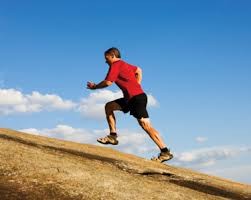Hill Sprints 101
Hill sprints are a great addition to almost any training program. They're tough on fat and easy on our joints which make them a no-brainer. Not to mention the fact that they help build lean muscle and ingrain proper running technique.
Continue to read on if you’re interested in learning more about hill sprint and how to implement them into your program.
What are hill sprints? Hill sprints can be broken into three parts:
- Sprint up a hill
- Walk back down
- Repeat
Who can benefit from hill sprint? As long as you can run you can benefit from hill sprints. Those that want to burn fat will do so because of the fact that they are doing some high intensity interval training (HIIT) which will cause your body to burn fat for hours after you’re done sprinting whereas traditional cardio where you go for a longer period of time at a lower intensity level only really burns fat during the time that you’re running/biking/rowing...
Athletes that want to build muscle can also benefit performing hill sprints. The last time I looked sprinters are pretty muscular. And since you’re constantly leaning forward while sprinting up the hill you learn proper body positioning for the acceleration portion of sprinting on a flat surface.

Why are they so good for you? Running up a hill is harder than running on flat ground or even downhill in regards to the amount of energy that you need to get from point A to point B. This is a good thing because the more energy we burn the more likely you are to force your body to break up unwanted fat stores. What’s even better is that running up hill takes away a lot of the stress that happens every time our foot strikes the ground when we sprint. Less stress on our joints means that we are reducing the chances of getting injured. Think of this car analogy. If you accelerated your car up a hill as fast as you could you would burn a lot of gas, this might not be the smartest move for your wallet since you don’t want to burn any more gas then you have to but when it comes to our bodies most of us would like burn as much fuel as we can in order to tap into those fat stores.
When should I do Hill Sprints? Hill Sprints are a great complement to just about any training program and can be done on days between weight training sessions without negatively hindering your performance in the weight room. If you performed downhill sprints the day before you went to the gym you’d have some pretty sore muscles in your legs which is another reason why (up)hill sprints reign supreme. The soreness that you experience from lifting weights actually happens not when you lift the weight but from when you lower the weight. This portion of each exercise is commonly known as a “negative” and in the exciting exercise science world we call it an eccentric muscle contraction. Uphill sprints minimize this type of muscle contraction which means that you can run hard one day and hit the gym the next without missing a beat.
Try doing one or two hill sprint sessions per week.
Where should I do hill sprints? Any hill will do but here are a few of our favorites:
Knox Mountain
Hartman Road hill in Rutland
The sand dunes in the Mission (it doesn't always have to on pavement)
How Should I Do Them? Since they are hill SPRINTS and not hill runs or jogs means that we don’t want you to be running for more than 60 seconds but we don’t want to them to be shorter than 20 seconds either. Your best bet is to pick out to specific land marks (fence posts, telephone poles etc) on your favorite hill that are anywhere from 100-200 meters apart. Time yourself to see how long it takes to sprint between these two posts.
Watch our Facebook page if you would like to join us for some hill sprints. If you are going to give them a try make sure to warm up well, ease into the workout and then do a thorough cool down and stretch. As you will be landing more on the ball or mid-foot be prepared for some post-workout calf soreness which should ease up in a day or so.
When you subscribe to the blog, we will send you an e-mail when there are new updates on the site so you wouldn't miss them.

Comments